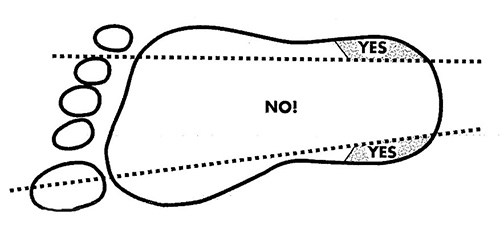Collection of Newborn Blood Spot Specimen
The heel stick is always the preferred method for collection of the newborn screening. Gloves should be worn for personal safety. Care should be taken to avoid contamination of blood collection circles with antiseptic solutions, powders, lotions, or other materials which may contaminate and adversely affect the testing process.
Sampling Technique
Collect the blood onto the labeled filter paper, using the following protocol:

- Cleanse the infant's heel with 70% isopropyl alcohol (use only rubbing alcohol). Note: Warming the skin-puncture site with a warm, moist cloth, or a heel-warming device, for 3 minutes can increase blood flow through the site.
- Allow heel to air dry.
- Using a lancet, or heel incision device, and wearing gloves, perform the puncture on the plantar surface of the heel (as indicated in the drawing). The puncture should be made to a depth of less than 2.0 mm with a sterile lancet or incision device.
- Gently wipe off the first drop of blood with sterile gauze or cotton ball. The initial drop contains tissue fluids that may dilute the sample.
- Wait for the formation of large blood droplets; apply gentle pressure with the thumb and ease intermittently as drops of blood form.
- Gently touch the printed side of the filter paper card to the blood drop and in one step, allow a sufficient quantity of blood to soak through and completely fill a pre-printed circle. Do not press the filter paper against the puncture site on the heel. Fill each printed circle with a SINGLE application of blood. Observe both sides of the filter paper card to assure that blood uniformly penetrated and saturated the card. Spotting should be done only on the printed side. The filter paper must not touch the skin puncture site.
- Fill the required number of blood spots for mandated tests.
- All used items should be disposed of in an appropriate biohazard container.
- Elevate the infant's foot above the body and apply pressure using sterile gauze. Do not apply adhesive bandages.
- Allow blood specimen to AIR DRY THOROUGHLY, on a horizontally level—non-absorbent open surface, such as a plastic-coated test tube rack—for a minimum of 3 hours at ambient temperature and away from direct sunlight. Do not stack, heat, or allow to touch other surfaces during the drying process. Insufficient drying can adversely affect the test results. Hair dryers, direct sunlight, or other sources of heat cannot be used to dry the specimen.
- Ship dried specimen AS SOON AS POSSIBLE, via courier service by the contract laboratory. Refer to shipment/courier section. Only use the mailing or courier envelope provided by the contract laboratory. Do not use plastic or sheet protector envelopes. Humidity and moisture are detrimental to the stability of dried blood spot specimens and can affect results.
Quality Assurance Tips
- Check the information on the filter paper card against the information on the newborn's wristband/bracelet prior to collecting the specimen so the right baby's blood is collected on the right filter paper card.
- Check the expiration date on the filter paper card before collecting the specimen.
- Before sending out to the newborn screening laboratory, filter paper specimens should be checked for:
- legibility,
- completeness,
- accuracy,
- quality of the blood spots,
- and the collection card has had at least 3-4 hours to dry.
Hospital Tracking of Specimens
The hospital (laboratory specimen send-outs) should keep a log of every birth and check-off when:
- Date/time blood spot specimen was collected
- Date/time blood spot specimen was shipped
- Date/time test results received
Shipping Specimens - Courier Service
Quick delivery of newborn screening dried blood spot specimens is crucial. Some disorders need to be identified, diagnosed, and treated as soon as possible to prevent the onset of clinical symptoms. It is important that submitting facilities are mindful of the time between collection and shipment. Facilities should have procedures in place that track and support the timely arrival of newborn screening specimens to the contract laboratory.
Place the dried specimen collection card inside the provided envelope and ship it by the contract laboratory’s designated courier. For further instructions regarding courier pickup, contact the State Hygienic Laboratory at the University of Iowa at 515-725-1630.
Specimen Collection Card Supplies
To order blood spot collection forms, contact the State Hygienic Laboratory at the University of Iowa (SHL) at 515-725-1630 or by FAX at 515-725-1650.
